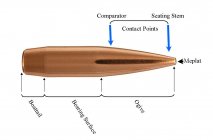kyotekiller25
Silver $$ Contributor
I have a couple questions here. So to start, I've been shooting long range, mainly 1K for the past 25 years, mainly hunting rifles and just 3 shot groups. In the beginning I seated to same COAL. As time progressed I started seating to the ogive. These days I can pretty much hold 4-6" 3 shot group at 1K laying prone/rear bag with my rifles. Which is good enough for me and what I'm doing anyway. I make sure all my rounds are identical to the ogive seating depth, after sorting bullets from longest to shortest, then starting out with the shorter ones I seat to the ogive I need, and turn the seater die down for the longer ones until they all match up ogive wise. It is a pretty lengthy and tedious process.
But, now a days I am almost more confused as when I started. I see people seating to COAL, versus the ogive and saying it's more accurate at long range. How can that be? I understand the BC part of it, but at the same time don't you want them all the same ogive/correlation to the lands also? You can't have both can you?
Its kinda hard for me to put this in words but if a guy seated all bullets to the same COAL, wouldn't there be a .001"-.010" difference in the ogive, or whatever variance is in the box of bullets at that point? Or vice versa by seating all to the same ogive, there'd be whatever difference in COAL due to the difference in overall bullet lengths?
Seems to me your always going to have up to say maybe a .010" variance in either ogive or COAL at that point, so which is typically more accurate at 1K+? Would love to hear from some of you better more experienced long range shooters on this and get some clarification, or at least how you do thing anyway.
Hoping I somewhat made sense rambling on here. Or maybe I'm just over thinking it all and just need to continue doing it the way I have been since I am still getting 1/2 MOA at 1K pretty routinely.
Thanks!
But, now a days I am almost more confused as when I started. I see people seating to COAL, versus the ogive and saying it's more accurate at long range. How can that be? I understand the BC part of it, but at the same time don't you want them all the same ogive/correlation to the lands also? You can't have both can you?
Its kinda hard for me to put this in words but if a guy seated all bullets to the same COAL, wouldn't there be a .001"-.010" difference in the ogive, or whatever variance is in the box of bullets at that point? Or vice versa by seating all to the same ogive, there'd be whatever difference in COAL due to the difference in overall bullet lengths?
Seems to me your always going to have up to say maybe a .010" variance in either ogive or COAL at that point, so which is typically more accurate at 1K+? Would love to hear from some of you better more experienced long range shooters on this and get some clarification, or at least how you do thing anyway.
Hoping I somewhat made sense rambling on here. Or maybe I'm just over thinking it all and just need to continue doing it the way I have been since I am still getting 1/2 MOA at 1K pretty routinely.
Thanks!












